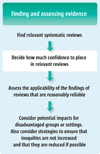SUPPORT Tools for evidence-informed health Policymaking (STP) 8: Deciding how much confidence to place in a systematic review
- PMID: 20018115
- PMCID: PMC3271835
- DOI: 10.1186/1478-4505-7-S1-S8
SUPPORT Tools for evidence-informed health Policymaking (STP) 8: Deciding how much confidence to place in a systematic review
Abstract
This article is part of a series written for people responsible for making decisions about health policies and programmes and for those who support these decision makers. The reliability of systematic reviews of the effects of health interventions is variable. Consequently, policymakers and others need to assess how much confidence can be placed in such evidence. The use of systematic and transparent processes to determine such decisions can help to prevent the introduction of errors and bias in these judgements. In this article, we suggest five questions that can be considered when deciding how much confidence to place in the findings of a systematic review of the effects of an intervention. These are: 1. Did the review explicitly address an appropriate policy or management question? 2. Were appropriate criteria used when considering studies for the review? 3. Was the search for relevant studies detailed and reasonably comprehensive? 4. Were assessments of the studies' relevance to the review topic and of their risk of bias reproducible? 5. Were the results similar from study to study?
Figures
References
-
- Renfrew MJ, Craig D, Dyson L, McCormick F, Rice S, King SE, Misso K, Stenhouse E, Williams AF. Breastfeeding promotion for infants in neonatal units: a systematic review and economic analysis. Health Technol Assess. 2009;13:1–iv. - PubMed
LinkOut - more resources
Full Text Sources



